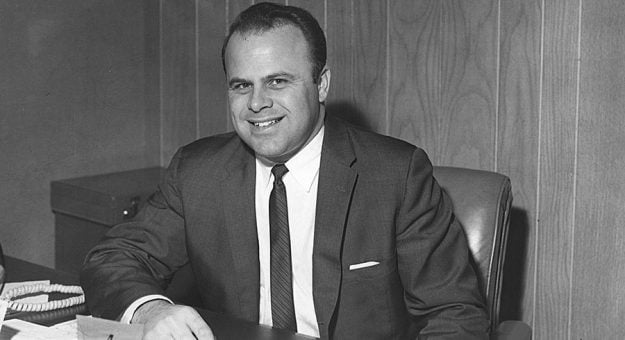INDIANAPOLIS — The late Neil Bonnett, full-time racer and part-time purveyor of country wisdom, once suggested that for all the good things television did for his sport, it had one serious drawback.
“TV,” he said, with his usual grin, “took all the lying out of racing.”
Gone were the days when he or one of his peers could make a careless mistake, tear a car to pieces, and give a team owner the excuse that had worked forever: “Something broke.”
Multiple cameras and endless replays, said Bonnett, put an end to that.
Which brings us to the internet, a staple of modern life that is mostly annoying, but which, when used in diligent research, does something similar to the TV cameras Bonnett joked about: It makes everything subject to replay and holds to account those who traffic in hogwash.
If you want to peddle nonsense, go right ahead. Just be aware that your nonsense lives on, in cyberspace’s closet.
As I watched this year’s U.S. Grand Prix, marveling at the number of fans — some 400,000 over three days — around the Texas jewel called Circuit of The Americas, a name jumped into my brain with enough force that I said it out loud: “Bruton Smith!”
Ollen Bruton Smith, founder of Speedway Motorsports LLC, has been in the sport forever. Charlotte Motor Speedway, the first significant track he played a part in, roared to life in 1960. His impact over the next six decades was enormous.
He believed the public perception of racing was directly tied to the quality of its venues, so his tracks offered comfort to the masses and luxury to CEOs and celebrities. As much as anyone, he dragged stock car racing into its modern era.
Smith is rich, meaning his wealth is measured in billions, and he is respected, as evidenced by his place in the NASCAR Hall of Fame. But, Lord, he can talk. Whenever his mouth is moving, pay attention. What he says might be outlandish or it might be sagacious, but it will not be dull.
What brought Smith to mind this time was something he said in 2012, shortly before COTA opened with the first F-1 race on these shores since 2007.
Reporters solicited his views on that event for three reasons: First, he owned Texas Motor Speedway, the other major motorsports facility in the state.
Second, the USGP conflicted with that season’s NASCAR Cup Series finale at Florida’s Homestead-Miami Speedway, and, despite all the verbal barbs he’d fired at NASCAR over the years, he was the sanctioning body’s strongest ally.
Third, every media person in racing knew Smith to be generally dismissive of anything in which he doesn’t play a role, so the odds were strong that he might say something catty. He did not disappoint.
“Go back and check it,” Bruton declared. “Formula 1 has never worked in this country.”
The problem with saying “go back and check it” is that your argument might hit the wall when somebody actually goes back and checks it. Research trumps hogwash.
The truth is, from 1961-’80, Formula 1 had a comfortable American home at Watkins Glen (N.Y.) Int’l. In fact, the USGP at the Glen drew praise as the best-organized event on the F-1 calendar, even in years when New York’s cold, wet Octobers — particularly brutal in 1979 — hurt ticket sales.
When track management never came up with the prize money for the ’80 race, the FIA waved goodbye.
True, F-1’s reputation in the U.S. wasn’t helped by visiting shoddy street courses in Detroit, Dallas and Phoenix, and another in a Las Vegas parking lot.
But it’s foolish to say that the USGP’s eight-year residency at Indianapolis Motor Speedway “never worked.” Its initial running drew a horde estimated at 250,000, making the 2000 U.S. Grand Prix “the best-attended Formula 1 race ever,” according to the New York Times. Subsequent Indy crowds slipped, but were solid until the tire debacle of 2005, when the withdrawal of all Michelin-shod teams turned a world-class race into a six-car farce.
But who needs facts when your default setting is catty? Here came Bruton’s final pre-race thought on that 2012 USGP at the Circuit of The Americas: “We’ve checked and about 10 people we know are going, so we’re not really concerned.”
Gee, if only the 265,419 other folks who poured into COTA that weekend — including a Sunday crowd of 117,429 — had been thoughtful enough to inform Smith of their intentions.
This year’s USGP numbers, as we have seen, dwarfed those from 2012. They also dwarfed the previous week’s NASCAR Cup Series turnout at Texas Motor Speedway, which newspapers called “sparse.”
There were sections in the TMS grandstands where O. Bruton Smith could have sung “Oh, Lonesome Me.”
Meanwhile, the Fort Worth Star-Telegram reported that the track was “further reducing the number of suites and seats.” The paper quoted a TMS executive as saying the track’s “sweet spot” for attendance “is about 75,000.”
Racing, like life, is cyclical. One form of the sport rises, another falls. Let’s hope that Kyle Larson — arguably the first Cup champion in years with a huge grassroots following — can help NASCAR recapture its mojo.
Meanwhile, remember the old saying that people who live in glass houses shouldn’t throw stones?
Ten years ago, Bruton Smith lived in a big, beautiful penthouse, but he was too busy slinging rocks and hogwash to notice his floor-to-ceiling windows.
